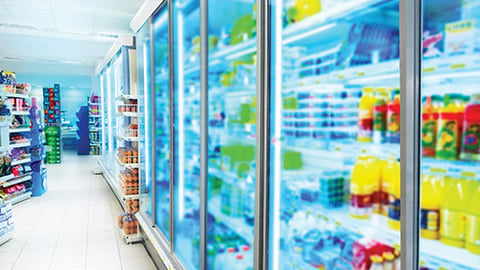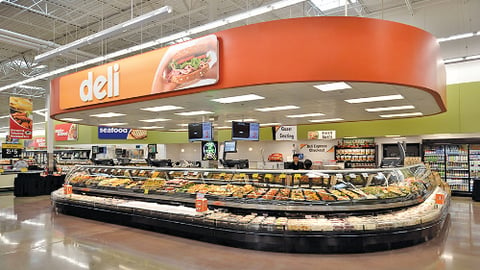Grocers, Store Designers Respond to New Aspects of Food Marketing
Key Takeaways
- When it comes to designing grocery stores, operators are increasingly following the mantra of “form follows function,” while at the same time endeavoring to remain flexible and adaptable.
- Companies are providing an increasing array of services to accommodate retailers in a one-stop design experience.
- The future of store design is customization, which includes a blurring of the lines between physical and digital environments.
The architect Louis Sullivan coined the well-known expression “form follows function,” and today’s supermarkets are a reflection of this mantra, albeit with the caveat that if the architecture dictates how the business actually operates, it runs the risks of inflexibility and an inability to adapt to change.
Bradley Anderson, owner and operator of Anderson’s Market, in Glenn Arbor, Mich., says of a complete store remodel in 2014, “We began by tailoring the layout toward functionality, with an eye on each department being its own profit center, giving it individuality as well as flow.”
According to Anderson, the remodel was designed to provide better customer interaction through lower-profile merchandising and open-air employee work areas.
“An emphasis was put on lighting, with a centerpiece skylight to allow natural sunlight to flood customer gathering areas,” he explains. “We also added a ‘Michigan Made’ section next to our deli to showcase our in-state products.”
Anderson collaborated with design professionals and used trade magazines like Progressive Grocer to help spot trends and make things more efficient for both customers and employees.
Eric White, director of marketing at Reading, Pa.-based Redner’s Markets Inc., observes that a recent conversion of an existing Warehouse Market into a new-concept Redner’s Fresh Market involved changes to interior design and décor, outdoor facia updates, new branding, and a refreshed color palette, as well as merchandising updates and the moving of departments. The project was a collaboration between the Redner’s design team and the outside design firm L&H Cos., also based in Reading, as well as Eden Prairie, Minn.-based wholesaler Supervalu.

Service Stars
On the designer side, companies are providing an increasing array of services to accommodate retailers in a one-stop design experience.
Food Market Designs, in Langley, Va., provides a multitude of design services, among them store planning for retail grocery, foodservice, commercial kitchen and specialty applications, as well as fixture drawings, equipment specifications, procurement, lighting design, working drawings, décor, refrigeration, project management and 3D renderings.
“We have recently upgraded our 3D-rendering software and equipment,” says Dan Phillips, president of Food Market Designs. “Our projects are located all over the United States, so having an accurate visual representation of a proposed interior concept is vital for the end user’s decision-making process.”

In the store design future, Phillips believes that the checkout-free Amazon Go concept is “extremely intriguing and could be a standard in the future of grocery. Labor and shrink are the biggest killers in grocery operations, so anything that can tackle reducing those percentages would only benefit the bottom line of an already small profit margin.”
Brad Knab, co-owner of Pewaukee, Wis.-based Mehmert Store Services, notes that his company has recently added 3D modeling and animation, which “enable our designs to come to life and communicate our clients’ vision graphically, so they can see it before they build it.”
Mehmert — which offers complete store design services, including site planning, store programming and fixture planning, as well as interior design and branding, exterior design, and composition — is customer-focused, meaning the shopper, Knab declares, adding that job No. 1 is reinforcing or changing the shopper’s experience.
“We can design cool new departments, suggest fresh offerings in stunning cases, or create a dynamic flow to help drive sales or attract new customers, but it really comes down to how the customer reacts to it,” he says.

Future Form and Function
Regarding the future, Knab says that there are physical innovations that are creating disconnections from human contact and driving store design, at least at the front end and on the sidewalk.
For example, click-and-collect and curbside pickup: What can be different? “It comes down to customer service or no customer service,” Knab says.
According to Wess Luke, principal at Cuhaci & Peterson Architects, Engineers and Planners’ Philadelphia office, the firm’s most recent design service addition is that it’s almost exclusively employing laser-scanning technology for existing- conditions surveys.
“The price point for this service has gone down enough that it fits within most budgets, and our clients see the value it provides to the overall project,” Luke says of the laser-scanning technology.
Orlando, Fla.-based Cuhaci & Peterson already provides a full menu of architectural and engineering design services, from hand-drawn sketches to photorealistic 3D renderings, along with programming, space planning, store planning, interior design, and fire alarm and fire protection.
Luke notes that two recent hot topics are working with clients to adapt stores to handle pickup of online orders, and the reduction of sales floor area to accommodate on-site fulfillment — micro-fulfillment — and other omnichannel capabilities. “It’s clear that the industry hasn’t settled on a best practice yet, as each client is integrating these concepts differently,” he adds.
Another design innovation he’s observed is in energy efficiency and recycling. Cuhaci & Peterson’s clients are instituting programs to collect waste from stores using the same infrastructure as product distribution, and collecting non-landfill waste from stores at the same frequency as product delivery has enabled his company to reduce the area in retail locations dedicated to handling or storing waste, both exterior and interior.
“We are also seeing increased interest in other energy-efficient options, such as site lighting with integrated solar panels,” Luke adds. “The future of store design is customization,” he asserts. “Store design will be more kit-of-parts, focused and regional.
"As enterprises understand their consumers on a more personal level, we will see the overall customer experience being tailored to a degree not yet realized. The digital experience obviously further augments customization. As designers, our challenge will be to blur the lines between physical and digital environments and truly partner with our clients to achieve business outcomes. Gathering and sharing data from multiple sources will be key to fine-tuning this process.”
Thus, different forms and different functions herald change — design change.







